Quebec has just simultaneously unveiled its 1990-2020 greenhouse gas (GHG) emissions report and its report on the achievement of 2020 GHG reduction targets. We learn that emissions on Quebec soil have decreased by 13% in 2020 compared to 1990, when the province’s objective was a 20% reduction. Despite the discrepancy between the figures, the government is claiming victory, and even more: our balance sheet would be a reduction of 26% below the 1990 level. How? Thanks to the carbon market we have with California.
There are indeed 11 million tonnes (Mt) of emission rights that were remitted by Quebec emitters to the government in 2020 that come directly from California. An emission right is not a reduction, but the right to emit a ton of GHGs into the atmosphere. However, California has issued more rights than necessary. The 11 Mt of Californian rights, acquired by emitters for a sum of approximately 256 million, are interpreted by the Quebec government as “reductions” of GHGs in California since the possibility of emitting GHGs there would have been removed. low. This is why these 11 Mt are accounted for as a “reduction” in the Quebec balance sheet.
If this calculation is technically correct, it is a somewhat creative accounting based on a large initial imbalance. This means that no GHG reduction has taken place in California in exchange for the purchase of emission rights by Quebec emitters. In 2020, we are well and truly 13% below 1990 emissions (and California is 14% below its original level), and without COVID-19 we would be 3%, which perfectly illustrates the fact that the Quebec approach to reducing GHG emissions does not work.
Explanation of the Great Imbalance
Unlike Quebec, which was aiming for 20% fewer GHGs in 2020 compared to 1990, and which determined the quantity of emission rights accordingly, California was only aiming for a 0% reduction in 2020 compared to 1990. It wanted simply return to its 1990 level, and not go below it. The quantity of emission rights that it issued and sold in the carbon market was therefore much greater than in Quebec.
Imagine a Christmas tree on which candy canes are placed by two aunts: Aunt Cali and Aunt Queb. Each cane corresponds to an emission right. Aunt Cali was generous and put in as many canes as when overconsumption of sugar was not an issue, and Aunt Queb put in 20% less canes. All the kids rushed at the canes, and some kids from Queb ate Aunt Cali’s canes. Since all the children were a little more reasonable (we had told them about cavities and the harmful effects of sugar), but above all a little sick (perhaps from COVID-19), they ate fewer canes: 13% less in Quebec and 14% less in California. No one was frustrated in their consumption: there were even candy canes left on the tree. Just as there are still emission rights in the market. The children of Queb ate the canes of Cali and therefore the children of Cali had less canes than they could have had. But they had too many from the start!
They therefore did not reduce their cane consumption, or what interests us here, their GHG emissions: the Christmas tree was too well stocked with emission rights, because of Aunt Cali.
The carbon market is glutted with emissions allowances, largely because California has put so many on the market. Quebec emitters took advantage of this to emit 11 Mt of GHGs with Californian rights, but without Californians having to reduce their emissions, since there were more rights available than necessary.
This abundance problem is partly resolved for 2030; California is aiming for a more ambitious goal than Quebec: minus 40%, compared to 37.5% here. We will no longer be able to use its excess emission allowances. If we use it, it will be this time because it will have made real reductions, to give us the opportunity to emit GHGs at home. And the government’s accounting will be fair.
But to believe today that Quebec has reduced its emissions by 26% is to forget that Santa Claus was very generous in California – and that in the end, it was the children who ate the most canes. who are going to have cavities.

